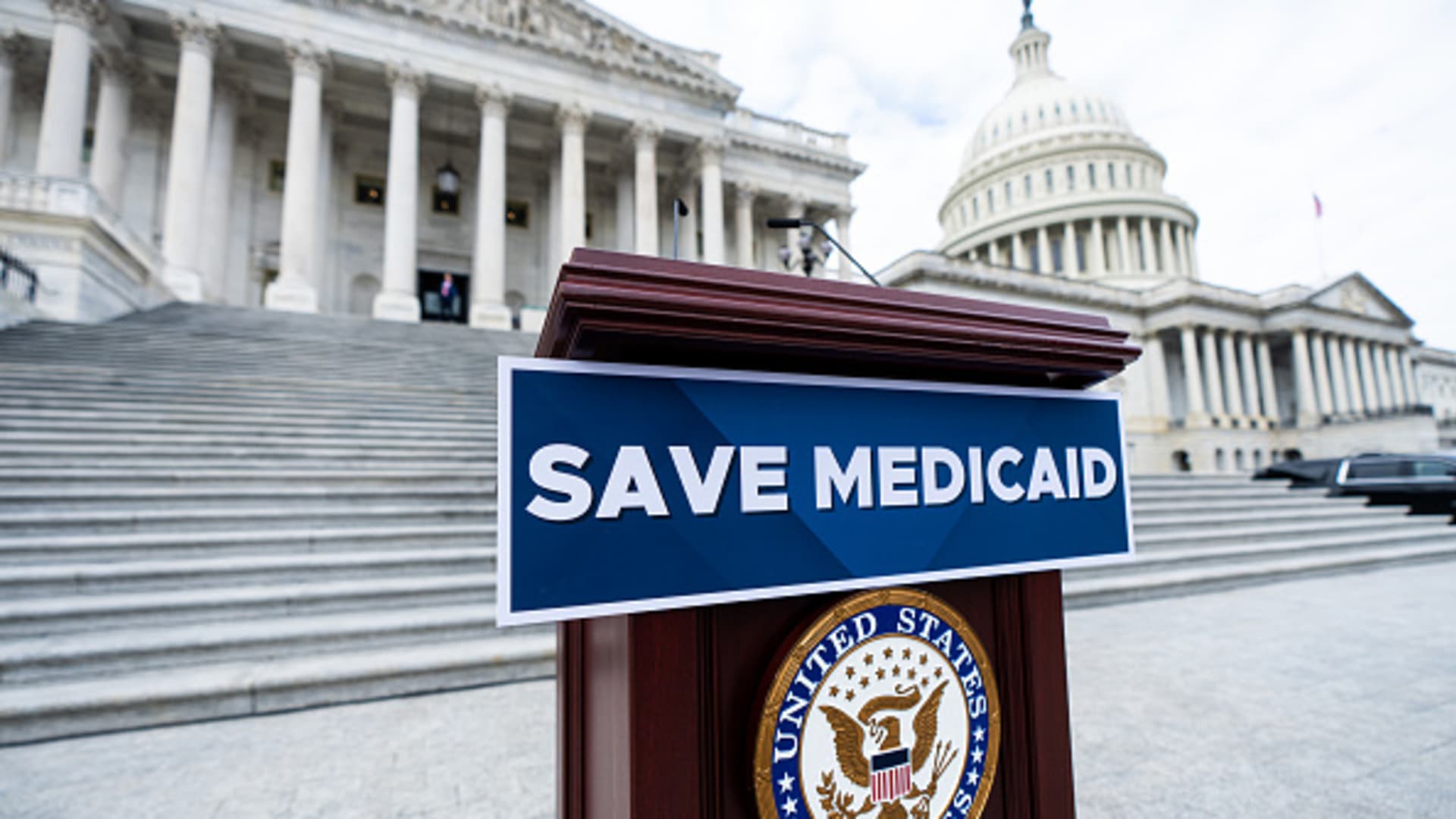Mrs | Moment | Getty Images
Rebecca Finch couldn’t think of a better gift for her 86th birthday.
She received a notice in early September from Navient that the lender would forgive the private student loan on which she was a co-signer.
“We’ve waived the remaining balance on your private student loan in the amount of $31,730.76,” the Aug. 29 letter said, in part.
Navient had determined that Rebecca qualified for its disability discharge. Rebecca received the news from the lender not long after CNBC wrote about the Finch family’s situation.
Rebecca Finch
Courtesy: Rebecca Finch
But the road to that relief was long, confusing and intensely stressful, said Rebecca’s daughter, Sabrina Finch.
“Finding out about the forgiveness option was very difficult,” said Sabrina, 53.
‘Transparency is severely lacking’
As the cost of higher education swells, the $130 billion private education loan industry has quickly grown. But private student loans come with few protections for those who run into repayment issues, including becoming disabled, consumer advocates say.
Only about half of the private lenders offer student borrowers the possibility of loan discharge if they become severely disabled and unable to work, according to an analysis by higher education expert Mark Kantrowitz.
In comparison, all federal student loans come with that option.
Even when a private student lender provides a disability discharge, it often doesn’t make the information widely known, advocates say.
“Transparency is severely lacking,” said Carolina Rodriguez, director of the Education Debt Consumer Assistance Program, or EDCAP, based in New York.
“It’s often difficult for borrowers to even reach a representative who is knowledgeable about the disability discharge option,” Rodriguez said.
More from Personal Finance:
How tax bracket changes could affect your brokerage account
Crypto relationship scams pose ‘catastrophic harm,’ SEC says
Many Americans would rather talk about politics than money
Anna Anderson, a staff attorney at the National Consumer Law Center, has seen that play out as well.
“Even the borrowers who allegedly have access to it, it’s still very, very difficult for them to actually seek and receive a discharge,” Anderson said.
On Sept. 9, in the course of reporting on the Finch family’s story, CNBC asked Navient if it had a link to a disability discharge application on its website.
“No,” Paul Hartwick, vice president of corporate communications at Navient, wrote in an email the same day.
He sent a link to a page on the lender’s website that encourages struggling borrowers to reach out to learn of their options. By the time of publication, that link no longer worked. Hartwick explained that that was because a different company, Mohela, or the Missouri Higher Education Loan Authority, began servicing the private student debt owned by Navient in October. That portfolio includes around 2.5 million borrowers.
Hartwick directed CNBC to Mohela’s website, which contained similarly limited information about loan discharge opportunities for those with disabilities.
In response to a request for comment, a Mohela spokesperson pointed CNBC back to Navient.
“MOHELA is a service provider for private loans and does not determine the benefits available by lenders,” the spokesperson wrote in an email. “Program attributes and terms are defined by each lender/loan holder.”
For comparison, the U.S. Department of Education has an easy-to-access disability application for federal student loan borrowers, and detailed information on its website about documentation and eligibility requirements.
Around 13% of Americans report having a disability, according to Pew Research Center. People with a disability are much less likely to be employed than those without one, and unemployment rates are far higher for those with disabilities, the U.S. Department of Labor found.
Disabled mother and daughter, and a $31,000 debt
Most private student lenders require a co-signer who is equally legally and financially responsible for the debt. That’s because student borrowers tend to have a thin or nonexistent credit history.
Originally, Sabrina was the primary borrower of the Navient private student loan, and her mother, Rebecca, was the co-signer. Rebecca co-signed the loan in 2007 while Sabrina — then in her 30s — was in school to become a nurse.
In the 20 years that followed, both women developed serious health issues.
In 2023, Sabrina was approved for Social Security disability benefits due to her bipolar disorder, she said. Even though she could no longer work, she assumed she was still responsible for the Navient loan. She researched her relief options but couldn’t find any information.
Sabrina said she just kept describing her situation to multiple customer service representatives at Navient. For weeks, those conversations led nowhere — until one day, an agent mentioned the disability option.
The next headache was figuring out the proof she’d need to gather, Sabrina said.
She only learned what the requirements were a few weeks later when Navient mailed her documents outlining the needed materials. In the end, Sabrina said, she sent as much information as she could to the lender, including evidence from her doctors.
In May, Navient excused Sabrina from her private student loan.
But that news was bittersweet. Almost immediately, the lender transferred the loan to her then 85-year-old mother.
Sabrina said she had told Navient that Rebecca has serious health conditions of her own, including cardiovascular disease and constant pain from a fractured hip. Several strokes have left Rebecca with speech and cognitive issues, Sabrina said. Sabrina spoke with CNBC on her mother’s behalf, given Rebecca’s extensive medical issues.
Even so, Sabrina said, a customer service agent at Navient told her that it would be hard for Rebecca to receive a loan discharge.
“Navient said that she would probably not be excused, regardless of [the documents] submitted,” Sabrina said.
On Oct. 25, Hartwick declined to comment on that conversation, but said that the private student loan was “discharged in full for Rebecca once her disability information was processed.”
But there’s no question it’s incredibly difficult for co-signers to be forgiven from a private student loan, consumer advocates say. The Consumer Financial Protection Bureau found in 2015 that private student lenders rejected 90% of co-signer release applications.
Advocates say those odds haven’t improved.
“Based on my experience, co-signer release is virtually non-existent in practice,” EDCAP’s Rodriguez told CNBC in August.
Navient’s attempts earlier this year to collect the debt severely upset Rebecca, Sabrina said.
The women were most afraid the lender could sue Rebecca and get a lien on her house in Troutville, Virginia. Sabrina said one of the callers from Navient mentioned that possibility to her mother.
A spokesperson for Navient told CNBC on Aug. 8 that he couldn’t comment on whether the lender discussed the possibility of a lien on Rebecca’s house.
“But I can say, in general, private student loans do not go into collections until after a period of delinquency,” he said. “And, like other loans, there’s a process, often lengthy, to take legal action toward repayment.”
On July 26, Sabrina emailed Navient as much information as she could on her mother’s physical condition, sending copies to CNBC.
Around two weeks after CNBC published an article on the family’s experience, Navient informed Rebecca that the lender would release her from the debt.
It was a tremendous relief to her and her mother, Sabrina said.
But she remains angry at how difficult she found it to even learn about the disability discharge option.
“There has got to be great deal of people out there that are disabled and fighting to stay afloat with these loans,” Sabrina said. “And I assure you the lenders are not volunteering the options for loan forgiveness to those asking them for help.”


 Economics1 week ago
Economics1 week ago
 Economics1 week ago
Economics1 week ago
 Economics1 week ago
Economics1 week ago
 Economics1 week ago
Economics1 week ago
 Blog Post1 week ago
Blog Post1 week ago
 Economics1 week ago
Economics1 week ago
 Economics1 week ago
Economics1 week ago
 Economics6 days ago
Economics6 days ago












